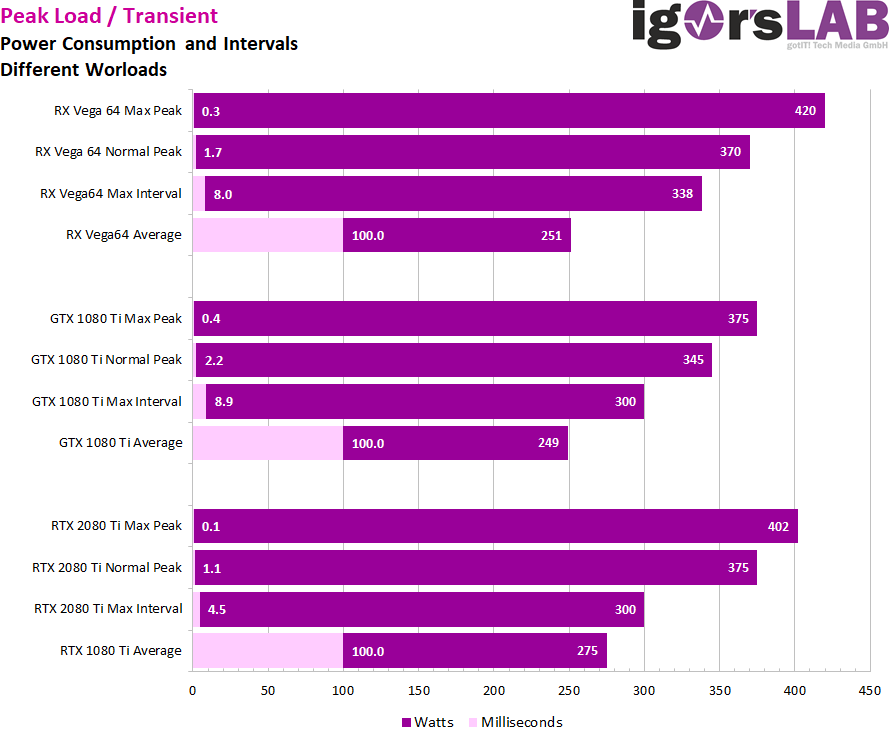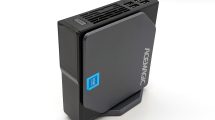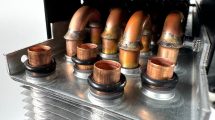Summary of measurement results
Modern switching power supplies should have no problems with the flowing currents produced by graphics cards. I couldn’t measure really sensationally high currents with any single card and in any of the different load situations. Spikes up to about 10 milliseconds are present, no question about it, because that is in the nature of things, because demanding games also cause very different load changes.
However, it never went beyond 40 amps, which is astonishing if you consider the scenario of the power supply manufacturer linked in the introduction. If you were to scale down to the nanosecond range, then peaks of up to 50 amps are also conceivable, but if an OCP or OPP already triggers, the circuitry is fucked up and you don’t have to blame the graphics cards.
It’s by no means a secret that AMD’s graphics cards switch at longer intervals than comparable Nvidia cards. But it is not so coarse that there are exorbitant high currents over many milliseconds. This is exactly what Power Tune knows how to prevent.
Correct power supply calculation
But what I would recommend, reserves back or forth, is an emotionless and in practice also clearly differentiated consideration of the possible power consumption or the flow of currents at the individual rails. To use the pure TBP (Typical Board Power) as a basis for a power supply calculation would be very blue-eyed and it suddenly becomes apparent why graphics card manufacturers often estimate significantly higher values. This is not a job creation program for the power supply industry, but pure caution.
Without a really detailed review in this area, it is of course very difficult to estimate where the power peaks lie and how long the intervals of the peak values actually are. But the inclusion of transients is indispensable for safe operation, because if the manufacturers of power supplies calculate one with a pointed pin, then it is the expensive capacitors. In the following overview I have summarized some values that caught my eye during all the measurements:

Bottom line
The very short load peaks can be put aside confidently and one should really only think about values that exceed one to two milliseconds. By the way, not only because of the possible switch-off of the power supply by a protective mechanism, but also because of the durability. The more hectically such a graphic accelerator sucks at the power supply unit, the faster the secondary capacitors get into the area of long-term care insurance. Who then saves in the end, is wrongly advised.
Something like 100% Japanese capacitors is of course also nonsense, because even the big Japanese companies now mostly manufacture in China. So you should first have a look at a really good power supply review, where the specifications of the secondary circuit are also discussed. Components make the difference, not any (embellished) measurement curves. If then I would orientate myself on the “normal peak” presented here, at most still on the maximum interval and hope that the manufacturer has put reserves on it of his own accord.
Bad advice is who calculates tightly on edge and hopes, it would somehow go well. A pi times thumbs can never harm a 50 to 100 watt reserve. And maybe I’ll build another power supply calculator based on the whole measured values. Time presupposed. And what remains for us now as a conclusion from the whole history?
The short-term line consumption of current graphics cards is sometimes considerably higher than the average values or what the chip manufacturers call Typical Board Power. These values are average values over a rather large interval. Depending on the quality of the secondary side of a power supply, the short-term load (1 to 10 ms) can be significantly higher.
So I would recommend to include 50 watts more room for manoeuvre in the power consumption ranges of the graphics card between 150 and 200 watts TBP and to simply add 100 watts of reserve for safety reasons in high-end systems from approx. 200 watts. This should cover the peculiarities of AMD and Nvidia cards well and you don’t have to spend hours checking the components. Most reviews don’t give anything like that anyway.
As a result of this test, I personally take it with me to give readers a power supply rating recommendation for my graphic card individual reviews in the future. Without hiring me out as a servant of the power supply industry, but rather as a well-meaning neighbour who might know better.
































Kommentieren